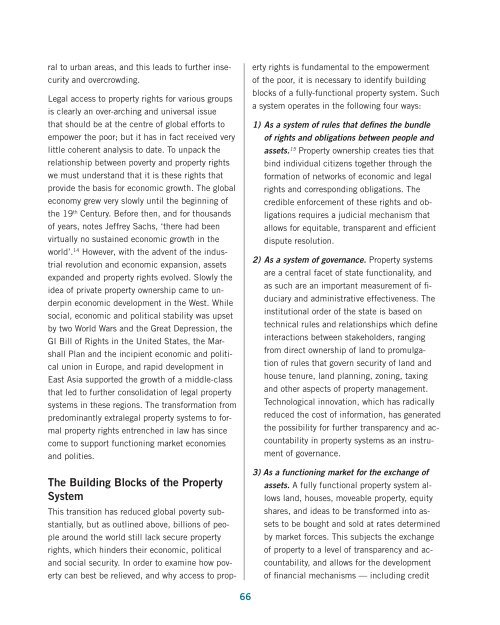Download the file - United Nations Rule of Law
Download the file - United Nations Rule of Law
Download the file - United Nations Rule of Law
You also want an ePaper? Increase the reach of your titles
YUMPU automatically turns print PDFs into web optimized ePapers that Google loves.
al to urban areas, and this leads to fur<strong>the</strong>r insecurityand overcrowding.Legal access to property rights for various groupsis clearly an over-arching and universal issuethat should be at <strong>the</strong> centre <strong>of</strong> global efforts toempower <strong>the</strong> poor; but it has in fact received verylittle coherent analysis to date. To unpack <strong>the</strong>relationship between poverty and property rightswe must understand that it is <strong>the</strong>se rights thatprovide <strong>the</strong> basis for economic growth. The globaleconomy grew very slowly until <strong>the</strong> beginning <strong>of</strong><strong>the</strong> 19 th Century. Before <strong>the</strong>n, and for thousands<strong>of</strong> years, notes Jeffrey Sachs, ‘<strong>the</strong>re had beenvirtually no sustained economic growth in <strong>the</strong>world’. 14 However, with <strong>the</strong> advent <strong>of</strong> <strong>the</strong> industrialrevolution and economic expansion, assetsexpanded and property rights evolved. Slowly <strong>the</strong>idea <strong>of</strong> private property ownership came to underpineconomic development in <strong>the</strong> West. Whilesocial, economic and political stability was upsetby two World Wars and <strong>the</strong> Great Depression, <strong>the</strong>GI Bill <strong>of</strong> Rights in <strong>the</strong> <strong>United</strong> States, <strong>the</strong> MarshallPlan and <strong>the</strong> incipient economic and politicalunion in Europe, and rapid development inEast Asia supported <strong>the</strong> growth <strong>of</strong> a middle-classthat led to fur<strong>the</strong>r consolidation <strong>of</strong> legal propertysystems in <strong>the</strong>se regions. The transformation frompredominantly extralegal property systems to formalproperty rights entrenched in law has sincecome to support functioning market economiesand polities.The Building Blocks <strong>of</strong> <strong>the</strong> PropertySystemThis transition has reduced global poverty substantially,but as outlined above, billions <strong>of</strong> peoplearound <strong>the</strong> world still lack secure propertyrights, which hinders <strong>the</strong>ir economic, politicaland social security. In order to examine how povertycan best be relieved, and why access to propertyrights is fundamental to <strong>the</strong> empowerment<strong>of</strong> <strong>the</strong> poor, it is necessary to identify buildingblocks <strong>of</strong> a fully-functional property system. Sucha system operates in <strong>the</strong> following four ways:1) As a system <strong>of</strong> rules that defines <strong>the</strong> bundle<strong>of</strong> rights and obligations between people andassets. 15 Property ownership creates ties thatbind individual citizens toge<strong>the</strong>r through <strong>the</strong>formation <strong>of</strong> networks <strong>of</strong> economic and legalrights and corresponding obligations. Thecredible enforcement <strong>of</strong> <strong>the</strong>se rights and obligationsrequires a judicial mechanism thatallows for equitable, transparent and efficientdispute resolution.2) As a system <strong>of</strong> governance. Property systemsare a central facet <strong>of</strong> state functionality, andas such are an important measurement <strong>of</strong> fiduciaryand administrative effectiveness. Theinstitutional order <strong>of</strong> <strong>the</strong> state is based ontechnical rules and relationships which defineinteractions between stakeholders, rangingfrom direct ownership <strong>of</strong> land to promulgation<strong>of</strong> rules that govern security <strong>of</strong> land andhouse tenure, land planning, zoning, taxingand o<strong>the</strong>r aspects <strong>of</strong> property management.Technological innovation, which has radicallyreduced <strong>the</strong> cost <strong>of</strong> information, has generated<strong>the</strong> possibility for fur<strong>the</strong>r transparency and accountabilityin property systems as an instrument<strong>of</strong> governance.3) As a functioning market for <strong>the</strong> exchange <strong>of</strong>assets. A fully functional property system allowsland, houses, moveable property, equityshares, and ideas to be transformed into assetsto be bought and sold at rates determinedby market forces. This subjects <strong>the</strong> exchange<strong>of</strong> property to a level <strong>of</strong> transparency and accountability,and allows for <strong>the</strong> development<strong>of</strong> financial mechanisms — including credit66
















